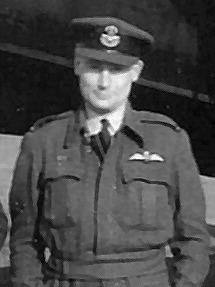William Meyer was born in London in 1910. His background was very unusual, his birth certificate is in the name of Wilhelm-Alex Meyer-Braselmann, his parents were German. The family company were importers and agents for a variety of industrial hardware, mostly from Germany. Their agencies included Primus, well known for their Primus stoves and associated equipment. After the death of his father in 1939 William, known as Bill, took over the running of the company. Despite being in an essential occupation Bill organised a reliable team to manage the company and, once they were in place in 1941, he volunteered. Facing the RAF Selection Board, he managed to persuade them to recommend him for pilot training despite his age of 31, the cut off for acceptance for pilot training.
In October 1941 Bill was sent to the USA for initial training at the Polaris Flight Academy at the aptly named War Eagle Field. Following that he completed his training at RAF Forres in the north of Scotland. He was then posted in December 1942, together with his newly formed crew, to join RAF IX (B) Squadron based first at RAF Waddington before moving to RAF Bardney. From January to June 1943, he flew numerous sorties to targets usually in what was known as ‘Happy Valley’, the heavily defended industrial heartland of the Ruhr Valley. He and his crew became known for the accuracy of their bombing earning special mentions in the squadron monthly reports. They also had an unusual success when, having been attacked by a Me 109 during a sortie to St Nazaire, they managed to shoot it down and returned unscathed.
Having completed a successful tour of 30 sorties Bill was awarded a DFC his recommendation reads:
This officer has carried out 30 sorties against enemy targets, involving 175 hours flying. He has at all times displayed the greatest determination to carry out his tasks to the best of his ability. His courage and leadership have made his crew extremely successful, and his tenacity has produced good results in the number of night photographs he has obtained of his targets. He is strongly recommended for the award of the Distinguished Flying Cross.
As was usual Bill was then ‘rested’ from operational flying for six months and sent to help train new crews at No. 82 Operational Training Unit, at Ossington. Here he survived a training accident that destroyed the Wellington that he had been instructing on. Following the crash the aircraft caught fire and he was lucky to escape with burns.
After he had recovered from his burns, he then volunteered to become a Pathfinder, the elite force that led the bomber stream and marked the targets accurately for the main force. A more dangerous role as not only did the Germans target the leading bombers but Pathfinder aircraft were unable to ‘weave’ over the target to enable the gunners to spot night fighters approaching underneath them as they had to fly straight and level in order to mark the targets with the utmost accuracy.
Bill joined 97 (Straits Settlements) Squadron in December 1943 and, now flying Lancasters again, flew throughout the winter of 1943/44. This was during the ‘Battle of Berlin’ when Bomber Command was sent repeatedly to Berlin. Bill, and those like him, now faced ever mounting losses during the long, icy nights in skies filled with flak, searchlights and fighters. On the night of 15/16 March 1944 Bill was the first to take off from RAF Bourn on a sortie to Stuttgart. The route lead over France before turning north near Lake Constance. There a German fighter Ju 88C flown by a German fighter ace, Hauptmann Horst Heinz Hissbach, picked him up on his radar. The Lancaster was raked with cannon shells setting the port engine on fire. The fire rapidly spread and there was an explosion. The aircraft broke up and crashed on the outskirts of a small hamlet, Zillhausen, in Germany. There were no survivors.
William Meyer was my father’s greatest friend, a name remembered from my childhood. Many years later, on coming across his photo and plaque in my parents’ effects, my husband and I decided to research Bill’s wartime history. It was the start of a lengthy search full of surprises. Bill’s German ancestry was a huge shock, when I told one of his first crew, he refused to believe it insisting that Bill was a typical English gentleman. Another surprise was finding a witness of the crash in Germany. Kurt Schneider, only fourteen at the time, had never forgotten that night and was able to tell us about it in great detail. Thanks to the support of local people and the Mayor of the nearest large town, Balingen, we were able to erect a memorial to William Meyer and his 97 Squadron crew on the site of the crash in Zillhausen. The unveiling ceremony was attended by men from IX (B) Squadron and two Tornados.
William’s entry on the IBCC Losses Database can be found here
